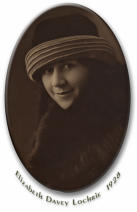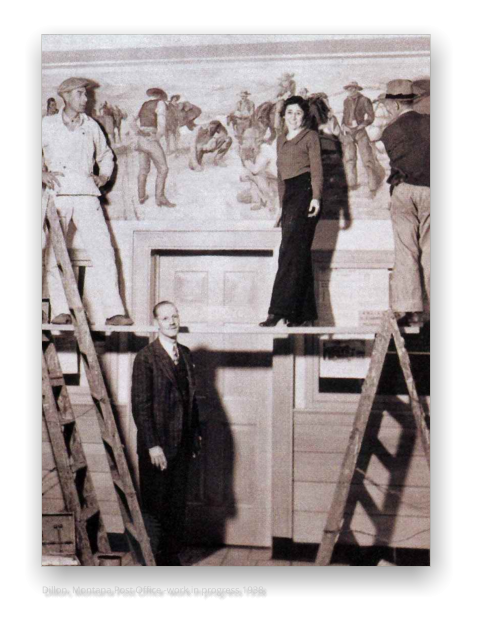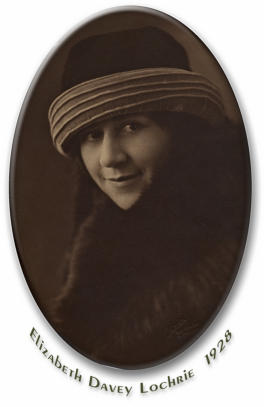

Biography July 1, 1890 - May 17, 1981
The “Daughter of Montana” is today widely recognized as one of the state's leading, twentieth century woman artists. Born and raised in Deer Lodge, Montana, Elizabeth completed an art degree at Pratt Institute in 1911. She then returned to Montana where she settled in Butte to raise a family of three and pursue a lifelong career as an artist. Best known for her portraits of local Native Americans, Elizabeth's work also includes rural and urban Montana landscape paintings, drawings and murals in a variety of media. Over the course of a half century, Elizabeth's work has been widely exhibited among New York galleries as well as galleries and public places in Montana. Today, the bulk of her work is in the permanent collections of three major Montana museums, The Hockaday Museum, The Montana Historical Society and The Holter Museum Netchitaki is remembered by her more immediate family as artist and honorary member of the Blackfoot Nation. As noted in the attached biography by Betty Lochrie Hoag McGlynn (1992), Elizabeth not only painted the Blackfoot people and their vanishing way of life, but like other artists and intellectuals of her time, she studied and immersed herself in their culture. She could converse in several Indian dialects and in 1932, the Blackfoot Nation adopted her, giving her the name, "Netchitaki" which means "Woman Alone in Her Way". For a complete Biography of her life and work the following PDF file is available: A Half Century of Paintings by Elizabeth Lochrie By Betty Lochrie Hoag -McGynn 1992 (Daughter of Elizabeth and prominent California Art Historian and writer) The following account is taken from the Biography by Elizabeth’s Daughter, Betty Lochrie Hoag McGlynn (PDF linked to above): “The following year Elizabeth returned to Glacier Park Station, bringing her young son with her. They rented a log cabin and remained all summer. On July 30, 1932, she wrote her husband in Butte: The Bull Childs want to take us into the tribe, give us Indian names and a certificate on buckskin telling the history of the name. They are choosing former tribe members' names ? "Oh, we don't mean pay-name; not up at the hotel at all; at our camp; and several of the old men of the tribe are going to come from Browning and all around. If you want to give us a present of cigarettes or beads, it would be nice. If not, we still want to give you this honor. Oke! Oke! You will have to learn to talk comaki." The adoption ceremony did proceed, with many prayers offered the night before and during the services. Elizabeth was given the name of a woman no longer living, Mollie Arrow Top, or Netchitaki, meaning "Lone Woman." (It should be noted that the Smithsonian records spell the name Netsetaki. There has been much confusion about English translation of Native American surnames. Elizabeth chose to retain the spelling given by her Blackfeet parents.) Her mother was Stocktokami (Under Howling Woman), a Blood Indian from Alberta. Her first father was the Piegan Chief medicine Boss Ribs (Stuckin-nutz). After his death Chief Olin Heavy Breast became her second father. A third and final father was Chief (Yellow Top) Theodore Last Star (Weasel Feather). Young Art Lochrie, taken into the tribe with his mother, became Chief Under Bear. Nine-years-old, he felt embarrassed about his new name and never talked about it. It was almost twenty years before Chief Bull Child sent the testimonies to Netchitaki. The two soft skins are irregularly oblong shaped, about 18" x 13". Around the edges there is a lace-like fringe of tiny carmine and green beads, probably sewn in place by Gypsy Bull Child. Pictograph figures in carmine and black ink tell the adoption story. The documents are signed by chiefs' hieroglyphical names. A fifth name appears on the skins, that of the noted Piegan artist who made the drawings on the documents, Chief Bull (Richard Sanderville), who died in 1951. The skins have been matted, glassed and framed for proper preservation. The message from the Blackfeet tribe to Netchitaki has been translated: This certificate is proof that many moons ago there came to us a white woman from far over the western mountains. She was friendly and understanding and we brought her into our Medicine Tepee and smoked a peace pipe with her and made her our sister, calling her name Net-chi-taki (Woman Who Came Alone). She has ever been true and helped with good deeds and paints our pictures to show the whole world. Signed by Chiefs George Bull Child, Fish Wolf Robe, Weasel Feather, and Heavy Breast.”
"News From the States" 44”x142” Dillon, Montana Post Office 1938
More information and full image on the Data & Links page
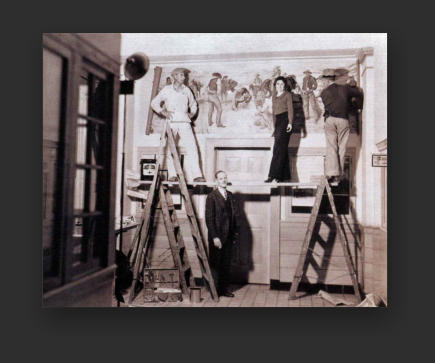

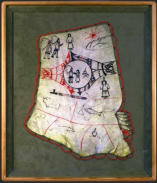

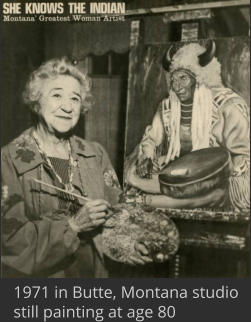




© Unless otherwise noted, all images, and
other web elements are copyright protected
©2018 Doane Hoag - doanehoag.com
Biography July 1, 1890 - May
17, 1981
The “Daughter of Montana” is today widely recognized as one of the state's leading, twentieth century woman artists. Born and raised in Deer Lodge, Montana, Elizabeth completed an art degree at Pratt Institute in 1911. She then returned to Montana where she settled in Butte to raise a family of three and pursue a lifelong career as an artist. Best known for her portraits of local Native Americans, Elizabeth's work also includes rural and urban Montana landscape paintings, drawings and murals in a variety of media. Over the course of a half century, Elizabeth's work has been widely exhibited among New York galleries as well as galleries and public places in Montana. Today, the bulk of her work is in the permanent collections of three major Montana museums, The Hockaday Museum, The Montana Historical Society and The Holter Museum Netchitaki is remembered by her more immediate family as artist and honorary member of the Blackfoot Nation. As noted in the attached biography by Betty Lochrie Hoag McGlynn (1992), Elizabeth not only painted the Blackfoot people and their vanishing way of life, but like other artists and intellectuals of her time, she studied and immersed herself in their culture. She could converse in several Indian dialects and in 1932, the Blackfoot Nation adopted her, giving her the name, "Netchitaki" which means "Woman Alone in Her Way". For a complete Biography of her life and work the following PDF file is available: A Half Century of Paintings by Elizabeth Lochrie By Betty Lochrie Hoag -McGynn 1992 (Daughter of Elizabeth and prominent California Art Historian and writer) The following account is taken from the Biography by Elizabeth’s Daughter, Betty Lochrie Hoag McGlynn (PDF linked to above): “The following year Elizabeth returned to Glacier Park Station, bringing her young son with her. They rented a log cabin and remained all summer. On July 30, 1932, she wrote her husband in Butte: The Bull Childs want to take us into the tribe, give us Indian names and a certificate on buckskin telling the history of the name. They are choosing former tribe members' names ? "Oh, we don't mean pay-name; not up at the hotel at all; at our camp; and several of the old men of the tribe are going to come from Browning and all around. If you want to give us a present of cigarettes or beads, it would be nice. If not, we still want to give you this honor. Oke! Oke! You will have to learn to talk comaki." The adoption ceremony did proceed, with many prayers offered the night before and during the services. Elizabeth was given the name of a woman no longer living, Mollie Arrow Top, or Netchitaki, meaning "Lone Woman." (It should be noted that the Smithsonian records spell the name Netsetaki. There has been much confusion about English translation of Native American surnames. Elizabeth chose to retain the spelling given by her Blackfeet parents.) Her mother was Stocktokami (Under Howling Woman), a Blood Indian from Alberta. Her first father was the Piegan Chief medicine Boss Ribs (Stuckin-nutz). After his death Chief Olin Heavy Breast became her second father. A third and final father was Chief (Yellow Top) Theodore Last Star (Weasel Feather). Young Art Lochrie, taken into the tribe with his mother, became Chief Under Bear. Nine-years-old, he felt embarrassed about his new name and never talked about it. It was almost twenty years before Chief Bull Child sent the testimonies to Netchitaki. The two soft skins are irregularly oblong shaped, about 18" x 13". Around the edges there is a lace-like fringe of tiny carmine and green beads, probably sewn in place by Gypsy Bull Child. Pictograph figures in carmine and black ink tell the adoption story. The documents are signed by chiefs' hieroglyphical names. A fifth name appears on the skins, that of the noted Piegan artist who made the drawings on the documents, Chief Bull (Richard Sanderville), who died in 1951. The skins have been matted, glassed and framed for proper preservation. The message from the Blackfeet tribe to Netchitaki has been translated: This certificate is proof that many moons ago there came to us a white woman from far over the western mountains. She was friendly and understanding and we brought her into our Medicine Tepee and smoked a peace pipe with her and made her our sister, calling her name Net-chi-taki (Woman Who Came Alone). She has ever been true and helped with good deeds and paints our pictures to show the whole world. Signed by Chiefs George Bull Child, Fish Wolf Robe, Weasel Feather, and Heavy Breast.”
"News From the States" 44”x142” Dillon, Montana Post Office 1938
More information and full image on the Data & Links page


